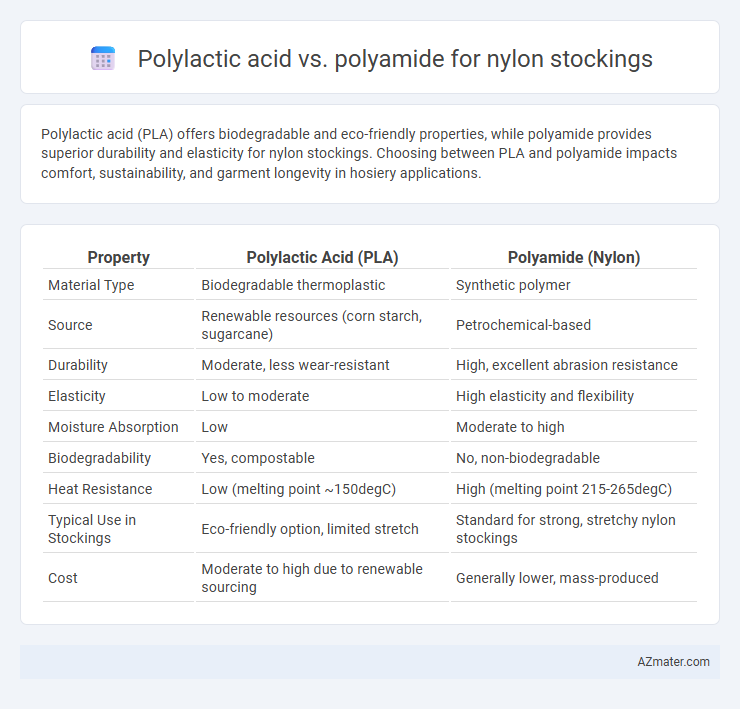Polylactic acid (PLA) offers biodegradable and eco-friendly properties, while polyamide provides superior durability and elasticity for nylon stockings. Choosing between PLA and polyamide impacts comfort, sustainability, and garment longevity in hosiery applications.
Table of Comparison
| Property | Polylactic Acid (PLA) | Polyamide (Nylon) |
|---|---|---|
| Material Type | Biodegradable thermoplastic | Synthetic polymer |
| Source | Renewable resources (corn starch, sugarcane) | Petrochemical-based |
| Durability | Moderate, less wear-resistant | High, excellent abrasion resistance |
| Elasticity | Low to moderate | High elasticity and flexibility |
| Moisture Absorption | Low | Moderate to high |
| Biodegradability | Yes, compostable | No, non-biodegradable |
| Heat Resistance | Low (melting point ~150degC) | High (melting point 215-265degC) |
| Typical Use in Stockings | Eco-friendly option, limited stretch | Standard for strong, stretchy nylon stockings |
| Cost | Moderate to high due to renewable sourcing | Generally lower, mass-produced |
Introduction to Polylactic Acid and Polyamide
Polylactic acid (PLA) is a biodegradable thermoplastic derived from renewable resources like corn starch or sugarcane, offering eco-friendly alternatives in textile manufacturing. Polyamide, commonly known as Nylon, is a synthetic polymer known for its strength, elasticity, and resistance to abrasion, widely used in durable stocking materials. Comparing PLA and polyamide highlights differences in environmental impact, biodegradability, and mechanical properties relevant to nylon stocking applications.
Material Properties of PLA and Polyamide
Polylactic acid (PLA) is a biodegradable thermoplastic derived from renewable resources like corn starch, featuring high tensile strength but limited elasticity and lower thermal resistance compared to polyamide. Polyamide, commonly known as nylon, exhibits exceptional elasticity, abrasion resistance, and superior thermal and chemical stability, making it highly suitable for nylon stockings requiring durability and stretch. The moisture absorption rate of polyamide is higher than PLA, which influences comfort and fit in hosiery applications.
Manufacturing Process of Nylon Stockings
The manufacturing process of nylon stockings using polyamide involves melt spinning, where polyamide pellets are melted and extruded through spinnerets to form fine fibers, followed by drawing, texturing, and weaving or knitting to create the fabric. In contrast, polylactic acid (PLA) fibers require a process of polymerization of lactic acid, followed by melt spinning similar to polyamide but with lower melting points and different thermal properties, impacting fiber strength and elasticity. Polyamide offers superior durability and elasticity essential for nylon stockings, whereas PLA, being biodegradable, presents eco-friendly alternatives but demands careful control of processing conditions to maintain fiber quality.
Sustainability and Environmental Impact
Polylactic acid (PLA) offers a more sustainable alternative to polyamide for nylon stockings due to its biodegradable properties and lower carbon footprint since it is derived from renewable resources like corn starch. Polyamide production relies heavily on petrochemical sources, resulting in higher greenhouse gas emissions and longer degradation periods in landfills. Choosing PLA-based stockings significantly reduces environmental impact by promoting circular economy practices and minimizing microplastic pollution.
Comfort and Wearability Comparison
Polylactic acid (PLA) offers superior breathability and moisture-wicking properties compared to polyamide, enhancing comfort for all-day wear in nylon stockings. Polyamide fibers provide higher elasticity and abrasion resistance, contributing to better shape retention and durability under frequent use. While PLA ensures a softer, eco-friendly feel, polyamide maintains consistent fit and longevity, making the choice dependent on prioritizing comfort or durability.
Durability and Longevity in Daily Use
Polylactic acid (PLA) fibers exhibit moderate durability in nylon stockings but tend to degrade faster under frequent stretching and moisture exposure compared to polyamide fibers. Polyamide offers superior longevity and resilience, maintaining shape and strength despite daily wear and repeated washing, making it the preferred material for high-performance nylon stockings. The enhanced abrasion and tensile resistance of polyamide significantly extend the lifespan of hosiery in regular use scenarios.
Breathability and Moisture Management
Polylactic acid (PLA) fibers offer superior breathability compared to polyamide, enhancing comfort for nylon stockings by promoting better air circulation and moisture evaporation. Polyamide, while durable and elastic, tends to trap heat and moisture, resulting in less effective moisture management during extended wear. Choosing PLA for nylon stockings improves wearability by ensuring a cooler, drier experience through its natural moisture-wicking and breathable properties.
Cost Analysis: PLA vs Polyamide
Polylactic acid (PLA) generally incurs higher raw material costs compared to polyamide when manufacturing nylon stockings, primarily due to its bio-based production process and lower economies of scale. Polyamide benefits from established global supply chains and mass production efficiencies, resulting in lower unit costs and widely available pricing stability. However, PLA offers potential long-term savings through biodegradability and reduced environmental compliance expenses, which can offset its initial higher purchase price in eco-conscious markets.
Market Trends in Eco-Friendly Hosiery
Polylactic acid (PLA) is gaining traction in the eco-friendly hosiery market due to its biodegradability and renewable sourcing from corn starch, appealing to environmentally conscious consumers. Polyamide, commonly known as nylon, remains popular for its durability and elasticity but faces increasing scrutiny for its non-biodegradable nature and reliance on petroleum-based resources. Market trends indicate a gradual shift towards PLA-based stockings as brands prioritize sustainable materials to meet regulatory pressures and consumer demand for eco-friendly alternatives in hosiery.
Future Prospects for Nylon Stocking Materials
Polylactic acid (PLA) offers a biodegradable alternative to traditional polyamide, significantly reducing environmental impact in nylon stocking production. Advances in PLA's mechanical properties and moisture-wicking capabilities are closing the performance gap with polyamide, enhancing comfort and durability. Emerging bio-based polyamides derived from renewable resources also promise sustainable solutions, positioning both PLA and innovative polyamides as key materials shaping the future of eco-friendly nylon stockings.

Infographic: Polylactic acid vs Polyamide for Nylon stocking
 azmater.com
azmater.com